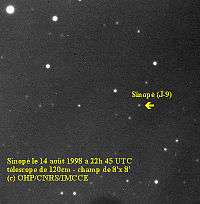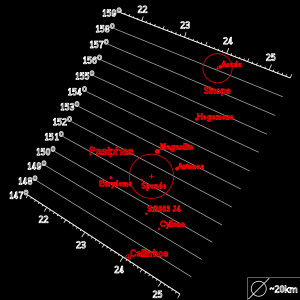Sinope (moon)
 | |
| Discovery | |
|---|---|
| Discovered by | S. B. Nicholson |
| Discovery date | July 21, 1914 |
| Orbital characteristics | |
| Periapsis | 18,237,600 km |
| Apoapsis | 30,191,200 km |
Mean orbit radius | 23,540,000 km[1] |
| Eccentricity | 0.25[1] |
| 724.1 d (1.95 a)[1] | |
Average orbital speed | 2.252 km/s |
| Inclination |
128.11° (to the ecliptic) 153.12° (to Jupiter's equator)[1] |
| Satellite of | Jupiter |
| Physical characteristics | |
Mean radius | ~19 km[2][3] |
| Volume | ~28,700 km3 |
| Mass | 7.5×1016 kg |
Mean density | 2.6 g/cm3 (assumed)[2] |
| 0.014 m/s2 (0.001 g) | |
| ~0.023 km/s | |
| Albedo | 0.04 (assumed)[2][3] |
| Temperature | ~124 K |
|
| |
Sinope (/sᵻˈnoʊpiː/ sə-NOH-pee;[4] Greek: Σινώπη) is a retrograde irregular satellite of Jupiter discovered by Seth Barnes Nicholson at Lick Observatory in 1914,[5] and is named after Sinope of Greek mythology.
Sinope did not receive its present name until 1975;[6][7] before then, it was simply known as Jupiter IX. It was sometimes called "Hades"[8] between 1955 and 1975.
Sinope was the outermost known moon of Jupiter until the discovery of Megaclite in 2000. The most distant moon of Jupiter now known is S/2003 J 2.
Orbit

Sinope orbits Jupiter on a high eccentricity and high inclination retrograde orbit. The orbital elements are as of January 2000.[1] They are continuously changing due to solar and planetary perturbations. It is often believed to belong to the Pasiphae group.[3] However, given its mean inclination and different colour, Sinope could be also an independent object, captured independently, unrelated to the collision and break-up at the origin of the group.[9] The diagram illustrates Sinope's orbital elements in relation to other satellites of the group.
Sinope is also known to be in a secular resonance with Jupiter, similar to Pasiphae. However, Sinope can drop out of this resonance and has periods of both resonant and non resonant behaviour in time scales of 107 years.[10]
Physical characteristics
Sinope has an estimated diameter of 38 km (assuming an albedo of 0.04)[3] The satellite is red (colour indices B−V=0.84, R−V=0.46).[9] unlike Pasiphae, which is grey.
Its infrared spectrum is similar to D-type asteroids also different from Pasiphae.[11] These dissimilarities of the physical parameters suggest a different origin from the core members of the group.
See also
- Sinope in fiction
- Ephemeris IAU-MPC NSES
References
- 1 2 3 4 5 Jacobson, R. A. (2000). "The Orbits of the Outer Jovian Satellites". Astronomical Journal. 120 (5): 2679–2686. Bibcode:2000AJ....120.2679J. doi:10.1086/316817.
- 1 2 3 "Planetary Satellite Physical Parameters". JPL (Solar System Dynamics). 2008-10-24. Retrieved 2008-12-12.
- 1 2 3 4 Sheppard, S. S.; and Jewitt, D. C.; An Abundant Population of Small Irregular Satellites Around Jupiter, Nature, Vol. 423 (May 2003), pp. 261-263
- ↑ http://dictionary.reference.com/browse/Sinope
- ↑ Nicholson, S. B. (1914). "Discovery of the Ninth Satellite of Jupiter". Publications of the Astronomical Society of the Pacific. 26: 197–198. Bibcode:1914PASP...26..197N. doi:10.1086/122336.
- ↑ Nicholson, S. B. (April 1939). "The Satellites of Jupiter". Publications of the Astronomical Society of the Pacific. 51 (300): 85–94. Bibcode:1939PASP...51...85N. doi:10.1086/125010. (in which he declines to name the recently discovered satellites (pp. 93–94))
- ↑ IAUC 2846: Satellites of Jupiter 1974 October (naming the moon)
- ↑ Payne-Gaposchkin, Cecilia; Katherine Haramundanis (1970). Introduction to Astronomy. Englewood Cliffs, N.J.: Prentice-Hall. ISBN 0-13-478107-4.
- 1 2 Grav, T.; Holman, M. J.; Gladman, B. J.; and Aksnes, K.; Photometric Survey of the Irregular Satellites, Icarus, Vol. 166 (2003), pp. 33-45
- ↑ Nesvorný, D.; Beaugé, C. & Dones, L. (2004). "Collisional Origin of Families of Irregular Satellites". The Astronomical Journal. 127 (3): 1768–1783. Bibcode:2004AJ....127.1768N. doi:10.1086/382099.
- ↑ Grav, T.; Holman, M. J. (2004). "Near-Infrared Photometry of the Irregular Satellites of Jupiter and Saturn". The Astrophysical Journal. 605 (2): L141–L144. arXiv:astro-ph/0312571
 . Bibcode:2004ApJ...605L.141G. doi:10.1086/420881.
. Bibcode:2004ApJ...605L.141G. doi:10.1086/420881.
External links
- Sinope Profile by NASA's Solar System Exploration
- David Jewitt pages
- Jupiter's Known Satellites (by Scott S. Sheppard)